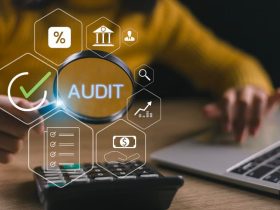Small business owners must do a crash course on accounting and all the terms associated with it. There is a complete system that makes accounting simple and easy. This systematic process is called the accounting cycle. This accounting cycle helps in maintaining the financial health of a business.
If you are relatively new to this concept, then this blogpost will help you understand what a financial cycle is with real-time examples. Make sure to stick till the end.
What is the accounting cycle?
So, let’s get our basics covered first.
An accounting cycle consists of steps that the accounting function in a business uses. This series of steps will help document and report the financial transactions.

There are seven steps in this process, but some companies only opt for five steps of the accounting cycle. Businesses need to follow through the eight steps to gain accuracy and stay on top of records.
Seven steps of the accounting cycle
As you already know accounting cycle now, it is time to understand the concept and all the steps associated with it in depth. We will be providing an example for each process to make it easy for you to understand.
1. Analyse transactions
It is the first and the most important step in the accounting cycle. So, what all comes under transactions?
Any purchases you make like broadband bill, rent, employee wages, etc., or sales whether in cash or on credit.
Signing contracts and creating purchase orders won’t come under transactions.
Example: A company sold its software product for £300 cash payment. It is the starting point of transactions.
2. Journal entries
The journal entries are the second step in the accounting cycle.
This entry must be done in chronological order as it impacts the other transactions and accounts present.
It will have credit and debit columns, which affect various accounts involved in the transaction.
The cash and receivable accounts have a debit balance, decreasing with credits and increasing with the debits.
In contrast, the revenue account has a credit balance, decreasing with debits and increasing with credits.
In the end, sum of all credits and debits must be equal.
It may confuse you a little, so here is a transaction example for your understanding.
Example: The £300 transaction is entered into a journal depending upon the date it happened. As it is a cash sale, there will be a debit of £300 in a cash account and a credit of £300 into sales revenue.
Meaning, cash increased by £300 and sales also increased by £300.
3. General ledger
A ledger account is the collection of all the journal entries organised under several ledger codes. Ledger codes are broadly divided under 5 main catogioeies:
- Assets
- Liabilities
- Equity
- Income
- Expenses
Be it debit or credit; it is a master of all the ledger accounts. It keeps track of the entire financial activity of a company. The summary of each journal entry is recorded in the ledger.
Example: Two transactions happened at business today- a cash sale of £300 and another cash sale of £200 with a refund of £100. The summary of this is a debit of £400 from cash transactions.
Sales revenue transactions are a credit of £500 with a debit of £100for sales returns, resulting in £400 total sales.
Some businesses record sales and sales returns separately.
4. Unadjusted trial balance
At the end of each accounting period, the accountants prepare an unadjusted trial balance.
It consolidates all ledger transactions. It is called unadjusted because the year-end adjustments are missing. The typical example includes adjustments for depreciation of tangible fixed assets, amortisation of intangible assets, prepayments, accruals, provisions etc.
The transactions here are unadjusted, and any changes are made in the sixth step.
Example:
At year-end, you have a dispute with a customer. A customer is seeking compensation for £900; however, your legal team believes it will settle for £500. In this case, you will record a provision of £500, debiting expense account in the profit and loss account while crediting provisions account on the balance sheet.
5. Check accuracy
This step is needed when the debits and credits won’t match in the above step. From reviewing the transaction list to ledgers, this process includes lots of double-checking to point out the error. The reverse journal entry will also take place to identify the real problems and fix them.
For example, if the credits in an account are £1,000 and the debit amount is £1,200, an accountant must find where the remaining £200 is.
If you are using accounting software, it will not allow unbalanced journal entries in the first place. However, there are times when this kind of error happen, and accountants must revise all the steps and conduct reverse journal entry if needed to sort out the issue.
6. Record adjusting entries
This step needs accountants to use matching principles to organise the transactions.
These adjustments are grouped into two- accruals and deferrals.
Deferral is a prepaid expense such as rent or broadband bill, whereas the accrual is a payable expense like employee salary or business taxes.
Example:
- On 01 January 2021, the company paid £1,200 as rent for the 12 upcoming months.
- The original journal entry will be £1,200 as rent expense in debit and £1,200 credit to cash.
- At the accounting period end, 31 January 2021, adjusting entry will be £1,100 debit to prepaid rent and £1,100 credit to rent expense.
- It means that only £100 was recorded as a rental expense in the accounting year, and the rest £1,100 was recorded as a prepaid asset on the balance sheet.
7. Prepare financial statements
Now that you are done with all the entries and adjustments, it is time to prepare financial statements.
There are a few components of these statements and are usually prepared in the following order.
- Income statement
- Statement of retained earnings
- Balance sheet
- Statement of cash flows
- Notes to the accounts
Net income derived from the income statement is used to make a statement of retained earnings. The ending balance on retained earnings will be used for the balance sheet. The cash flow statement uses all of these three income statements to provide better insights. Notes to the accounts provide additional information and a breakdown of the balances.
Remember that none of the accounts should be reflected on more than one statement. It is important to prepare these statements in the above order as they are connected with others.
Example:
- According to your income statement
- Your total revenue is £1,000
- The expense is £400
- Now the net income is total revenue – expense: £1,000 – £400 = £600
- This £600 is moved to retained earnings. Let us say your retained earnings right now are £300; the ending balance in the statement of retained earnings will be £900, assuming that you haven’t paid any dividends.
- This ending of retained earnings is equity on the balance sheet. In a cash flow statement, you will see cash inflows and cash outflows. The cash flow statement is further classified into operating, investing and financing activities.

Wrapping up
Despite the size of your business, even if you are using a cash accounting method, it is essential to understand the accounting cycle. An accounting cycle can be your guide in managing the transactions of your business and also comes in handy when you are filing the taxes. I hope you have got an understanding of it from our guide to full accounting cycle examples.









Leave a Reply